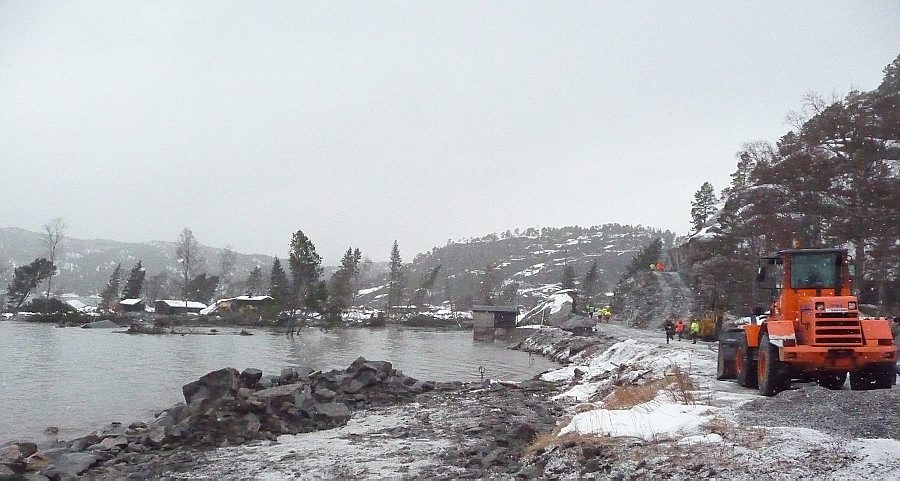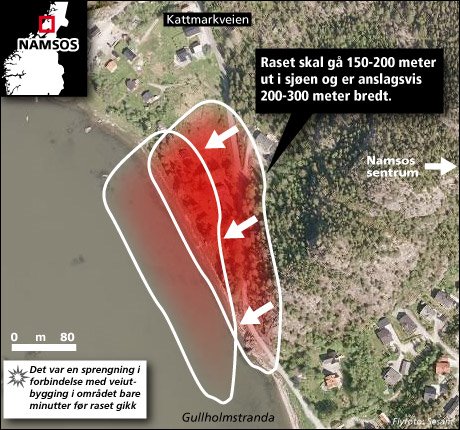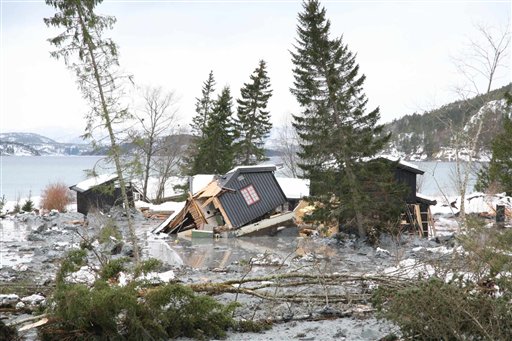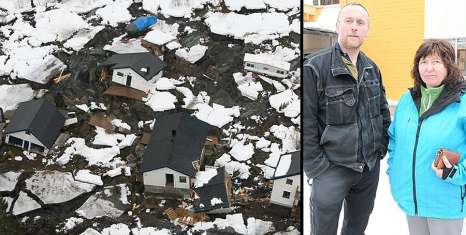13 March 2009
Norwegian landslide – is this a quick clay slide?
Posted by Dave Petley
Most people would probably not think of Norway as being hazard prone, but it does have two particular landslide issues. The first is that occasional large-scale failures occur on the walls of fjords. Given the height of these rock walls, these failures can be large and energetic, and sometimes trigger small scale tsunamis. The other is a strange type of failure known as a quick clay slide. Perhaps the best way to explain a quick clay slide is to direct readers towards the original landslide viseo, which shows the Rissa slide. This is described at the site below, which also contains the video in two parts:
http://www.ce.washington.edu/~geotech/courses/cee522/RissaLandslide/rissa.html
Do take a look – the film is amazing. quick clay slides occur in marine clays that have an unstable structure. Disturbance of that structure can cause a massive reduction in strength, which then destabilises the slope allowing failure on even low slope angles. In the case of Rissa, a small excavation for the foundations of a barn was enough to trigger the failure.
Today, reports have emerged of a landslide at Namsos in Norway that has destroyed ten or so houses. Fortunately there have been no fatalities. Various pictures of the landslide are available – these two particularly caught my eye (from here and here – click on the image for a better view in a new window. The people are homeowners I think):

Familiar? It is clear that this is a landslide occurred in clay on a pretty low angle slope on the edge of a lake. What’s more, the newspaper reports (e.g. this one) suggest that “It happened near a road construction site, and NRK said it could be related to blasting or excavation.” I don’t know for certain that this is a quick clay landslide, but I have my suspicions, especially when I look at this image of the site (from here):

There are a some other pretty good images around too, mostly focusing on the aftermath. For example, this one (from here) shows the displaced houses:
 Whilst this one (from here) shows just what a low angle slope the failure occurred on. Presumably the road works in the foreground are the proposed cause of the problems:
Whilst this one (from here) shows just what a low angle slope the failure occurred on. Presumably the road works in the foreground are the proposed cause of the problems:

Quick clay landslides are pretty rare (I have never seen one) if rather dramatic.



 Dave Petley is the Vice-Chancellor of the University of Hull in the United Kingdom. His blog provides commentary and analysis of landslide events occurring worldwide, including the landslides themselves, latest research, and conferences and meetings.
Dave Petley is the Vice-Chancellor of the University of Hull in the United Kingdom. His blog provides commentary and analysis of landslide events occurring worldwide, including the landslides themselves, latest research, and conferences and meetings.
I am from this particular part of Norway, to be accurate, Verdal, a small town about 80 miles south of this site.This is a region of Norway that has been historically very active with regards to this kind of natural disasters. The biggest of which hit my hometown in 1893, killing 1893 and ultimately leading to an exodus that would last for over 30 years.Today, the scars in the landscape is only visible to the trained eye. We have had several small sized landslides in modern times, but none at that particular scale, and efforts have been made to secure those areas most at risk.The slide was merely documented, as it happened 116 years ago. However, you might find some of the pictures on the following site useful;http://www.geoportalen.no/nyheter/verdalsraset/A further update on the Namsos slide; there are now being conducted police investigations as to what caused the clay slide, and which authorities are to blame for this near disaster.RegardsThor H.Pettersen
The number of deaths in the Verdal slide was of course 116, not 1893 as I had mistakenly written.
The link to the Rissa landslide doesn’t work
Here is the link to the Rissa landslide:http://geotechnical.ce.washington.edu/courses/cee522/RissaLandslide/rissa.html
Report on the slide
http://www.regjeringen.no/upload/SD/Vedlegg/Veg%20og%20vegtrafikk/skredet-i-kattmarkvegen_NTNU-rapport2009.pdf.